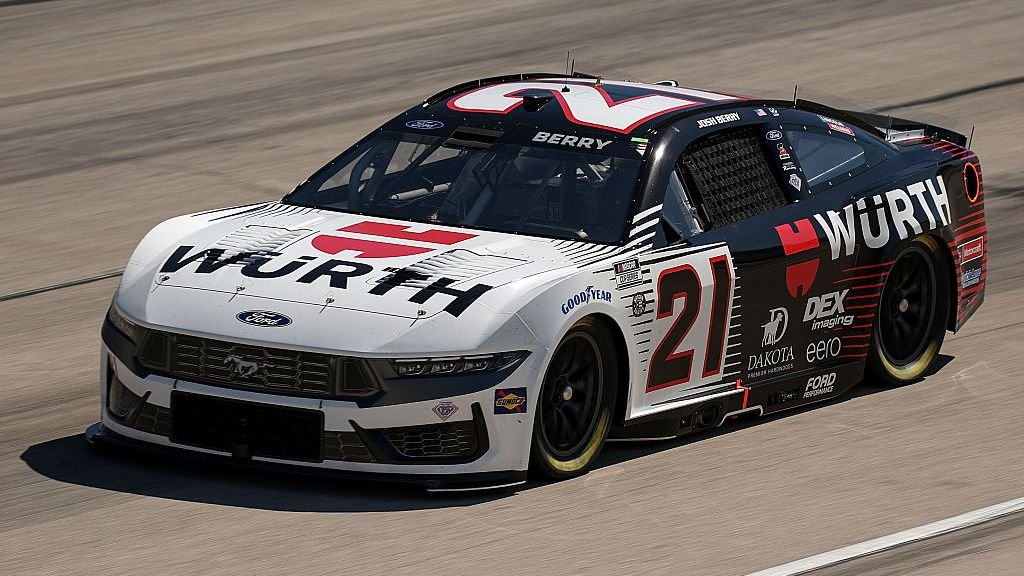Josh Berry experienced a moment of unexpected vulnerability that cost him the lead during the Wurth 400 at Texas Motor Speedway on Sunday. At the helm of the Wurth Ford Mustang, representing Wood Brothers Racing, Berry was in a strong position when he encountered an unforeseen bump in Turn 4, resulting in a crash on lap 125. The car lost traction and spun out, ultimately colliding with the outer wall. Interestingly, just one lap prior, Berry had navigated the same lane without any issues, leading him to believe he had a solid grip on the race.
“I thought I was all right,” Berry communicated to his crew after the incident. The collision inflicted significant damage on his vehicle, necessitating repairs that pushed him briefly behind the pit wall. Despite the setback, Berry managed to return to the race after the necessary fixes.
“Getting the car to perform optimally in Turns 1 and 2 is quite a challenge; it often puts you on edge in Turns 3 and 4,” Berry reflected. “I felt like my car had strong potential. I’ll definitely review the incident to see if there were choices I could have made differently, but in the end, I think my biggest fear was being too slow rather than spinning out like that.”
During the race, Berry led for 41 laps, showcasing his prowess by taking the lead at the end of the first stage after exiting pit road first. Following the restart, he successfully maintained his lead against his Ford teammate, Austin Cindric, and later held off Kyle Larson during a restart on lap 94.
Just before his crash, Berry had built a lead of under one second. “The car was performing really well,” he noted. “From the early stages, it was clear that we had a strong setup, especially after the first pit stop when we made some adjustments. We got ahead and felt confident about our position. However, as I approached the lap traffic, I knew I had to maneuver differently. You can’t just follow the slower cars; you risk losing your own handling. I was working my way around the No. 62 on the outside and felt good about it. Then, as I tried to catch the No. 51, I hit that bump and lost control.”
Berry expressed uncertainty about what he might have done differently, acknowledging the inherent risks involved in racing, especially on a track like Texas Motor Speedway. “In these cars, you have to be fast, and that often means being on the edge of control. Unfortunately, that edge caught us today,” he remarked.
After the crash, Berry finished the race in 32nd place, marking a disappointing outcome. He has been working to regain his form since his victory at Las Vegas Motor Speedway back in March, where he last managed a top-10 finish.
The Wurth 400 presented an array of challenges for drivers, with Texas Motor Speedway’s unique characteristics testing their skills and endurance. The high-speed track demands a fine balance between speed and control, pushing drivers to their limits. Each turn offers a different set of obstacles, and the slightest miscalculation can lead to catastrophic results, as Berry experienced firsthand.
As Berry continues to analyze his performance, he recognizes the need for resilience in the face of setbacks. The world of NASCAR is unforgiving; drivers must learn quickly from their mistakes to stay competitive. Berry’s incident serves as a stark reminder of the unpredictable nature of racing, where the thrill of leading can shift to the agony of a crash in mere moments.
The NASCAR season is long, and each race provides an opportunity for drivers to adapt and improve. Berry has shown promise throughout the season, and while this race may have ended in disappointment, it also offers valuable lessons that can be applied in future competitions. The ability to bounce back from adversity is a hallmark of great athletes, and Berry is determined to harness that spirit as he moves forward.
Moreover, the camaraderie among drivers, teams, and fans plays a significant role in the NASCAR community. Support from teammates like Cindric and fellow competitors can be instrumental in helping drivers cope with the ups and downs of racing. Berry’s experience at the Wurth 400 highlights the importance of teamwork and communication in navigating the challenges of the sport.
As the season progresses, Berry and his team will undoubtedly analyze their strategies and make necessary adjustments. The road to recovery from a crash involves not only physical repairs to the car but also mental resilience and strategic planning for upcoming races. Each lap on the track is an opportunity for growth and improvement, and Berry remains committed to refining his skills and seizing future opportunities.
The NASCAR schedule is filled with diverse tracks that offer different challenges, and as Berry prepares for the next race, he will draw on his experiences to enhance his performance. The competitive nature of the sport means that every driver is constantly striving to improve, and Berry is no exception. With determination and hard work, he aims to reclaim his spot among the top contenders.
Fans and enthusiasts of NASCAR will continue to follow Berry’s journey closely as he navigates the highs and lows of the racing season. The thrill of the chase, coupled with the unpredictability of the sport, keeps audiences engaged and invested in the outcomes of each race. Berry’s resilience and commitment to improvement make him a driver to watch in the upcoming events.
In conclusion, while the Wurth 400 did not unfold as Berry had hoped, it is just one chapter in a long season filled with potential. The lessons learned from this race will undoubtedly shape his approach moving forward, and with each race, he has the opportunity to turn setbacks into comebacks. The essence of NASCAR is defined not just by victories but by the stories of perseverance and the relentless pursuit of excellence.
